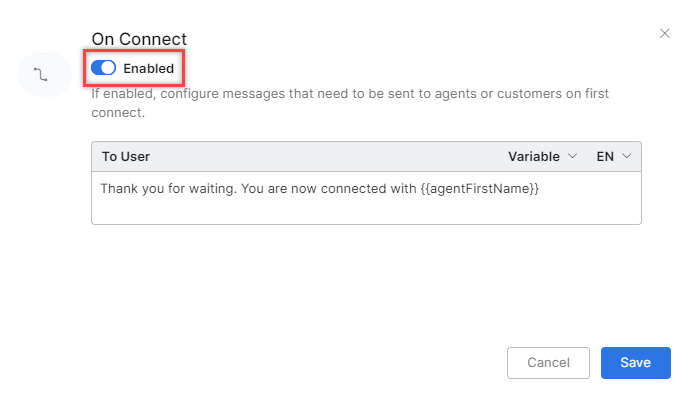Agent Settings lets you configure the settings that apply to all agents across SmartAssist.
Go to CONFIGURATION > USER MANAGEMENT > Agent Settings to view and edit the following:
- Answer Mode: These settings let you define how conversations get answered on each channel (Digital – Chats, and Emails, as well as Voice).
- Conversation Status Control: These options let you define how conversation status behaves and the messages triggered by status changes.
- Call Recording Control: These settings let you configure call recording behavior. If enabled, you can further enable options to allow Agents and Virtual Assistants to Pause/Resume call recording.
- Transfers: This section lets you define settings related to External Transfers, Skill Match, and Transfer Destination Control.
- Skill Modification: You can decide if the agents can modify skills attached to a conversation.
- Auto Logout & Auto Close Conversation: Administrators can configure this setting to specify a period of inactivity for automatic agent logout and a conversation timeout to transition into ACW mode.
- Snooze: This setting allows agents to temporarily pause conversations that are waiting for a reply from the customer’s end or any necessary action or item on the agent’s side.
- Additional Routing Configuration: Administrators can select from the following routing options that complement existing routing configurations through queues.
- Fairer Workload distribution.
- Hold interaction in queue until the wait time expires.
- Enable Dial Tone Until Agent Connects: This setting plays a dial tone to the customer until the connection with the agent is established after the user hears connected tone.
- Total Digital Conversation Limit: This setting prevents digital overload by limiting the total number of active conversations across all channels.
These settings are grouped and presented as closed groups when first opening the Settings screen. Click any group to view its corresponding options.
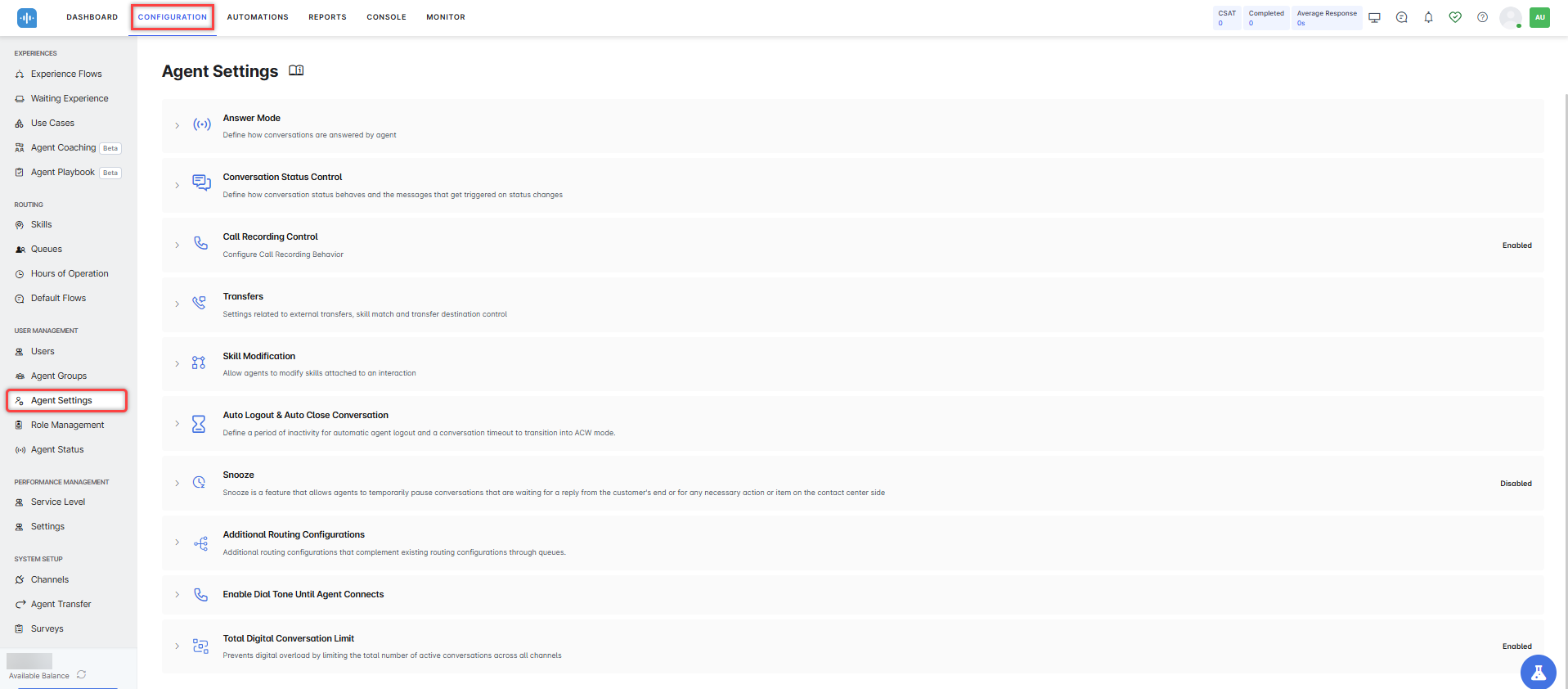
Answer Mode
Chats
- Manual: Agents must click Accept to begin chatting with the next customer. Set the acceptance timeout for agents before a chat returns to the queue by entering the number of minutes and seconds.

- Auto: Chats are auto-answered, and the agent does not need to click ‘Accept’. Set the first response timeout for agents to respond to new chats.

Voice
- Manual: Agents must click ‘Accept’ to begin their voice interaction with the next customer.

- Auto: Calls are auto-answered. The agent does not need to click ‘Accept’.

Emails
- Manual: Agents must click ‘Accept’ to begin their email interaction with the next customer. Set the acceptance timeout for agents before an email returns to the queue by entering the number of minutes and seconds.

- Auto: Emails are auto-accepted, and the agent does not need to click ‘Accept’.

Explicit Reject Button
Turn on the toggle to add an explicit reject button for incoming conversations. This applies only in manual acceptance mode. This toggle is turned off by default.

Conversation Status Control
The Conversation Status Control settings are available for the following channels: Live Chat, Messaging, Voice, and Emails.
Different statuses apply to each channel. Watch the short demo below to see what these look like in SmartAssist, and read the following sections for details on available statuses and their configuration.
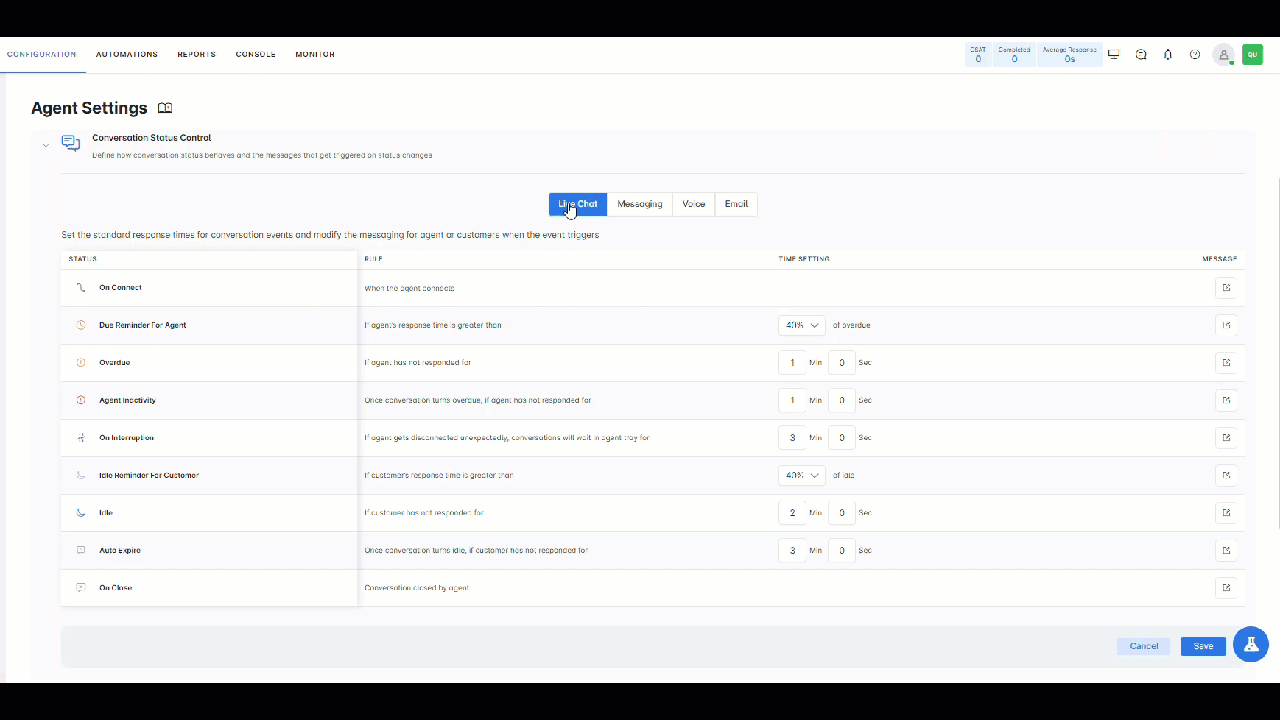
Conversation Statuses by Channel (Live Chat, Messaging, and Voice)
Conversation statuses apply in certain conditions for specific channels. These are listed in the table below:
| Status | Applicability | Channel | Message | Variables |
| On Connect | When the agent connects | Live Chat, Messaging (Configurable). | To User | Agent Full Name, Agent First Name, Agent Last Name, Agent Nick Name |
| Voice | To User | Agent Full Name, Agent First Name, Agent Last Name, Agent Nick Name | ||
| Due Reminder For Agent | If the agent’s response time is greater than the set percentile of overdue conversations. | Live Chat, Messaging. | To Agent | Agent Full Name, Agent First Name, Agent Last Name, Agent Nick Name Elapsed Time, Expired Time. |
| Overdue | If the agent has not responded for the set amount of time (in minutes and seconds). | Live Chat, Messaging. | To Agent | Agent Full Name, Agent First Name, Agent Last Name, Agent Nick Name Elapsed Time, Expired Time. |
| Agent Inactivity | If the agent has not responded to an overdue conversation for the set time (in minutes and seconds). | Live Chat | To Agent | Agent Full Name, Agent First Name, Agent Last Name, Agent Nick Name Elapsed Time, Expired Time. |
| Snooze | If the agent marked the customer on Snooze. | Live Chat, Messaging. |
To User | Agent Full Name, Agent First Name, Agent Last Name, Agent Nick Name, Snooze Open Time. |
| To Agent | Agent Full Name, Agent First Name, Agent Last Name, Agent Nick Name, Snooze Open Time. |
|||
| Idle Reminder For Customer | If the customer’s response time is greater than the set percentile of total idle customer conversations. | Live Chat, Messaging. | To User | Agent Full Name, Agent First Name, Agent Last Name, Agent Nick Name Elapsed Time, Expired Time. |
| Idle | If the customer has not responded for the set amount of time (in minutes and seconds). | Live Chat, Messaging. | To User | Agent Full Name, Agent First Name, Agent Last Name, Agent Nick Name Elapsed Time, Expired Time. |
| Auto Expire | If the customer’s response time is greater than the set amount of time (in minutes and seconds). | Live Chat | To User | Agent Full Name, Agent First Name, Agent Last Name, Agent Nick Name Elapsed Time, Expired Time. |
| To Agent | Agent Full Name, Agent First Name, Agent Last Name, Agent Nick Name | |||
| On Interruption | If the agent disconnects unexpectedly. | Live Chat, Messaging. | To User | Agent Full Name, Agent First Name, Agent Last Name, Agent Nick Name. |
| On Customer Interruption | If the customer disconnects unexpectedly. | Live Chat | To Agent | Agent Full Name, Agent First Name, Agent Last Name, Agent Nick Name. |
| On Close | If the agent closes the conversation. | Live Chat, Messaging (Configurable). | To User | Agent Full Name, Agent First Name, Agent Last Name, Agent Nick Name. |
Conversation Statuses by Channel (Email)
| Status | Applicability | Channel | Message | Variables |
| Overdue | If the agent has not responded for the set amount of time (in hours and minutes). | To Agent | Elapsed Time, Expired Time, Time Left to Inactivity, Time Left to Expiry. | |
| Due Reminder for Agent Inactivity | If the agent’s response time is under the set amount of time (in hours). | To Agent | Elapsed Time, Expired Time, Time Left to Inactivity, Time Left to Expiry. | |
| Agent Inactivity | The conversation will be moved back to Queue, once it turns overdue if the agent has not responded for the set amount of time (in hours and minutes). | To Agent | Elapsed Time, Expired Time, Time Left to Inactivity, Time Left to Expiry. | |
| Snooze | If the agent marked the customer on Snooze. | Live Chat, Messaging. |
To User | Time Left to Inactivity, Time Left to Expiry. |
| To Agent | Time Left to Inactivity, Time Left to Expiry. |
|||
| Agent Offline | If an agent gets disconnected unexpectedly, conversations will wait in queue for a set amount of time (in hours and minutes). | To Agent | ||
| Customer Idle | If the customer has not responded for the set amount of time (in hours and minutes) since the last agent response. | To User | Elapsed Time, Expired Time, Time Left to Inactivity, Time Left to Expiry. | |
| Due Reminder for Auto Expiry | If the customer’s response time is under the set amount of time (in hours) before Auto Expiry. | To User | Elapsed Time, Expired Time, Time Left to Inactivity, Time Left to Expiry. | |
| Auto Expire | Once the conversation turns idle if the customer does not respond for the set amount of time (in hours and minutes) the interaction expires. | To User | Elapsed Time, Expired Time, Time Left to Inactivity, Time Left to Expiry. | |
| To Agent | Elapsed Time, Expired Time, Time Left to Inactivity, Time Left to Expiry. | |||
| On Close | If the conversation is closed by the agent. | To User | Time Left to Inactivity, Time Left to Expiry. |
Conversation Status Configuration
For each status, you can configure the following:
- The response time after which the status should trigger: This can be set in either as a percent value of a total or as minutes and seconds.
- The statuses for which you can set a percent value are: Due Reminder For Agent, and Idle Reminder For Customer.
- The statuses for which you can set a response time (in minutes and seconds) are: Overdue, Agent Inactivity, Idle, and Auto Expire.
- The statuses that do not require percentile or response time configuration are: On Connect, On Interruption, and On Close.

The following applies to emails:
- The statuses for which you can set a response time (in hours) are Due Reminder for Agent Inactivity, and Due Reminder for Auto Expiry.
- The status for which there is no response time is On Close.
- The statuses for which you can set a response time (in hours and minutes) are Overdue, Agent Inactivity, Agent Offline, Customer Idle, and Auto Expire.
- The messaging goes out to either the user or the agent. Status Messages can be edited by clicking the Edit icon under the Message column.

- Each status lets you edit the message text, add variables and select the language.
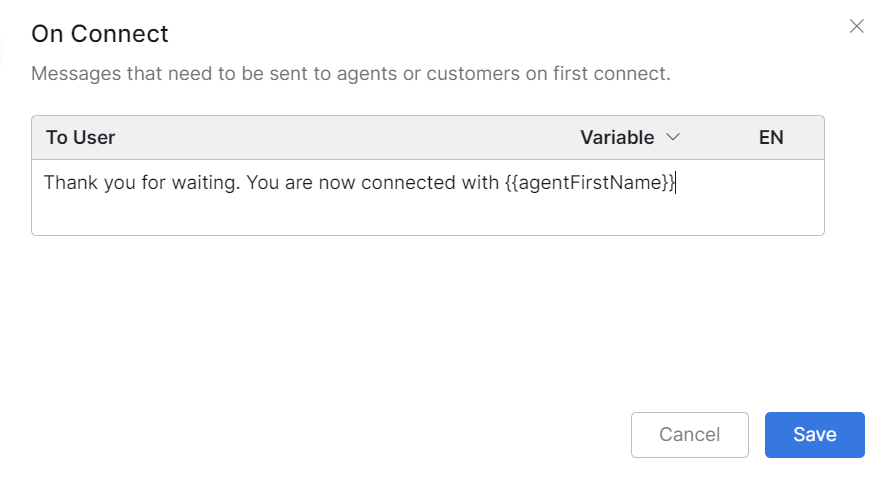
- To add a variable, place the cursor where you want to insert the variable, click the Variable field, then select the one you need. This adds a variable placeholder in your message text, which will be replaced with contextual information once the message reaches its recipient. You can select more than one variable within the same message.
For example:{{agentFirstName}}becomes Christine Mark.

See the tables in Conversation Statuses by Channel (Live Chat, Messaging, and Voice) and Conversation Statuses by Channel (Email) for details on available variables.
- Each status lets you edit the message text, add variables and select the language.
- Configurable Agent Transfers Messages and Optional Conversational Status Control for ‘On Connect’ and ‘On Close’ (digital channels only):
Once you configure your Conversation Statuses and Messaging, click Save at the bottom right of the Agent Settings screen.
Call Recording Control
By default, SmartAssist records all voice interactions. SmartAssist admins can disable call recording for all voice interactions.

Allow Agent to Pause/Resume
By default, the Allow Agent to Pause/Resume feature is disabled. However, admins can enable it for agents handling voice interactions, allowing them to pause the recording during the call.

Allow Virtual Assistant Dialogs to Pause/Resume
By default, the Allow Virtual Assistant to Pause/Resume feature is disabled. However, admins can enable it for virtual assistants (automation) handling voice interactions, allowing them to pause the recording when collecting Personally Identifiable Information (PII).

Recorded calls are accessible to supervisors on the Dashboard’s Interactions tab. The interactions are not recorded in the interactions tab for the duration that the recording was stopped/paused.
Changes to the Call Recording Control settings are logged on the Kore.ai Bots Admin Console > Analytics > Audit Report page.
Transfers
Transfer to External Contacts
If enabled, this option allows agents to transfer ongoing customer calls to the external contacts list, via the Agent Console. Please see Agent Console > Transfer Interactions to learn more.
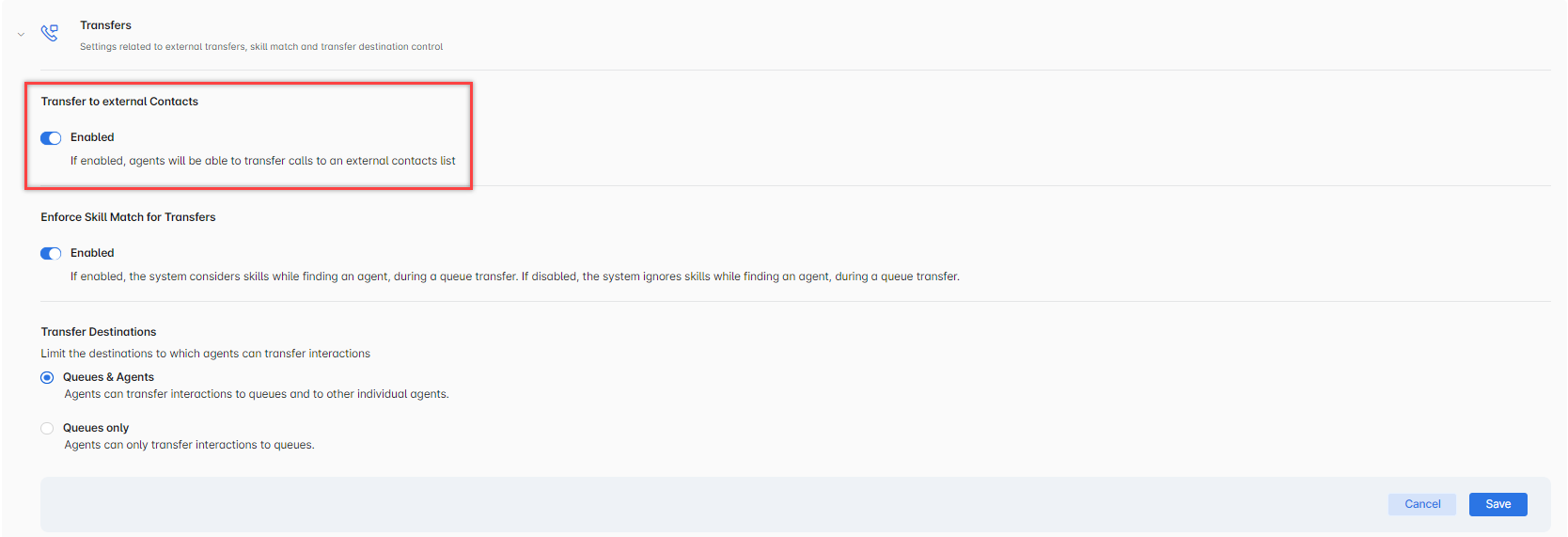
Enforce Skill Match for Transfers
If enabled, the system considers skills while finding an agent, during a queue transfer. If disabled, the system ignores skills while finding an agent, during a queue transfer.
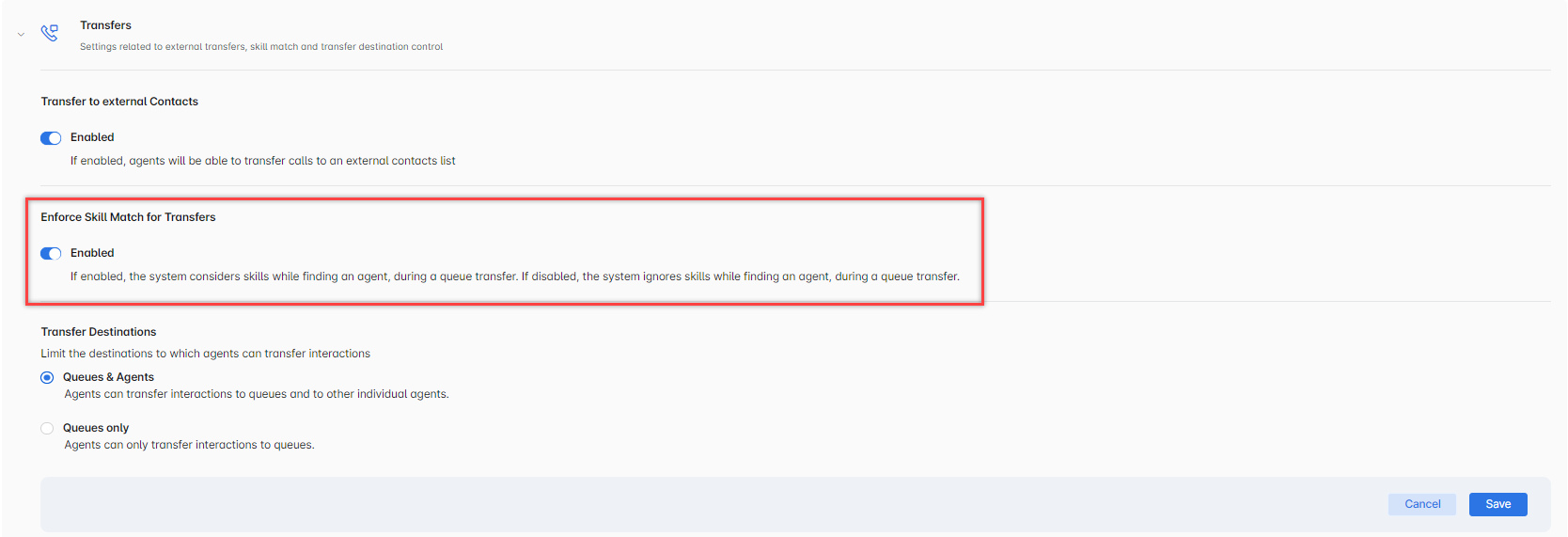
Transfer Destinations
Supervisors can decide where agents can transfer interactions:
- Queues & Agents: Agents can transfer interactions to queues and other individual agents.
- Queues only: Agents can transfer interactions only to queues.
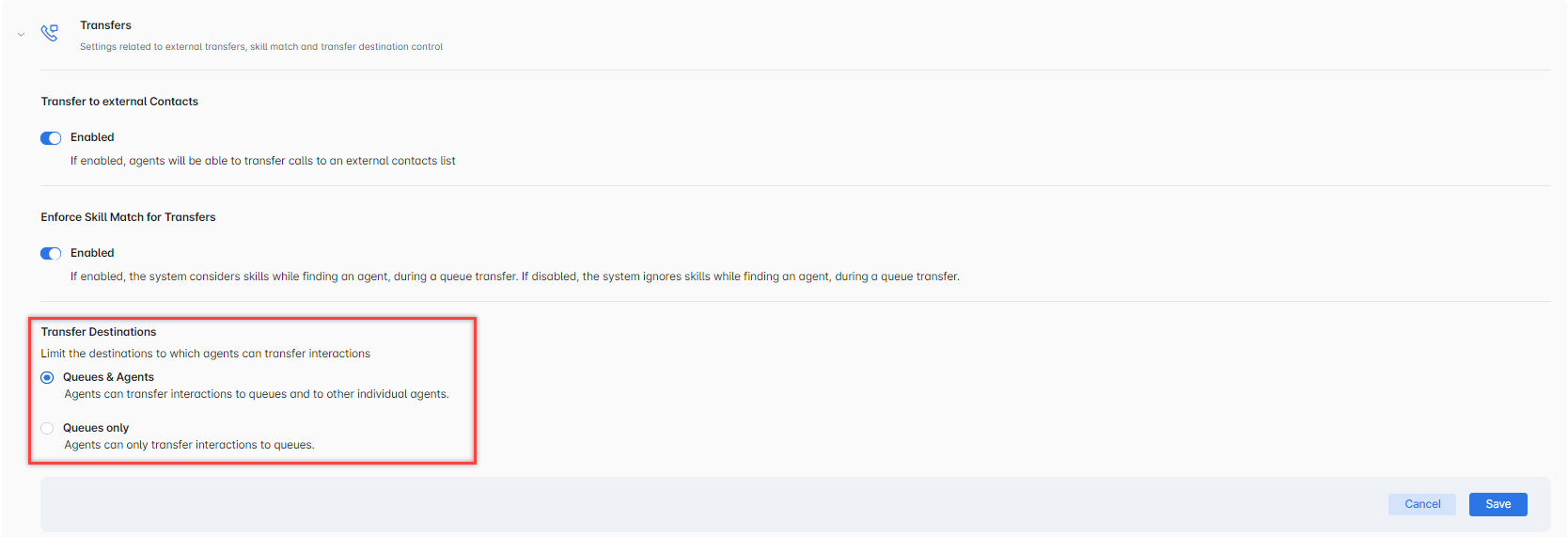
Skill Modification
If enabled, the system allows agents to modify skills attached to an interaction.
You can select from the following options:
- Live Interaction: Selecting this option lets agents modify skills from the skills bar on the Live Interaction window.
- Transfer: Selecting this option lets agents modify skills when transferring an interaction.

Auto Logout & Auto Close Conversation
This feature allows administrators to specify the period of inactivity for automatic agent logout and a conversation timeout to transition into ACW mode. By default, auto logout & auto close conversation is disabled.

Enabling the setting allows administrators to configure the following rules:
Auto Logout: The period of inactivity after which auto logout occurs. The default setting is 8 hours.
Due Reminder for Auto Logout: The time duration before auto logout when the alert message appears.

Conversation Callback Timeout:
If enabled, the conversation automatically moves to ACW mode after the timeout period if the agent remains inactive on the callback screen. 30 Seconds is the default selection, you can configure it between 10 seconds and 5 minutes.

Snooze
This feature allows agents to temporarily pause conversations that are awaiting a response from the customer or require any necessary action from the agent.
By default, the snooze functionality is disabled. Administrators can turn on the Snooze toggle to enable the functionality.

Additional Routing Configuration
Administrators can select from the following routing options that complement existing routing configurations through queues.
Fairer Workload distribution: When enabled, this feature distributes tasks evenly across agents, which reduces overload, improves focus, and can decrease completion times.
Hold interaction in queue until the wait time expires: When enabled, interactions remain in the queue till the set queue max timeout, regardless of agent availability.

Enable Dial Tone Until Agent Connects
By default, the enable dial tone until agent connects functionality is disabled. Administrators can turn on the toggle and click Save to enable the functionality. When enabled, a dial tone is played to the customer until the connection with the agent is established after the user hears a connected tone.

Total Digital Conversation Limit
This setting allows admins to configure a maximum total digital conversation limit for an agent while adhering to the per-channel limits that are configured. Learn more.
When the Total digital conversation limit is reached, an agent will move to System Busy status. This setting is disabled by default.

